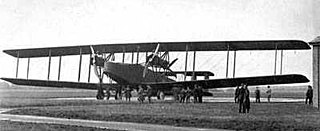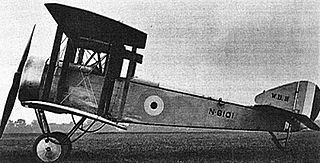Related Research Articles

The Aichi B7A Ryusei was a large and powerful carrier-borne torpedo-dive bomber produced by Aichi Kokuki for the Imperial Japanese Navy Air Service during the Second World War. Built in only small numbers and deprived of the aircraft carriers it was intended to operate from, the type had little chance to distinguish itself in combat before the war ended in August 1945.

The Handley Page V/1500 was a British night-flying heavy bomber built by Handley Page towards the end of the First World War. It was a large four-engined biplane, which resembled a larger version of Handley Page's earlier O/100 and O/400 bombers, intended to bomb Berlin from East Anglian airfields. The end of the war stopped the V/1500 being used against Germany, but a single aircraft was used to carry out the first flight from England to India, and later carried out a bombing raid on Kabul during the Third Anglo-Afghan War. It was colloquially known within the fledgling Royal Air Force as the "Super Handley". The V/1500 which was shipped to Canada to attempt a transatlantic flight was flown in the US, and in 1919 crash-landed in a field at Mount Jewett, Pennsylvania. Photos appeared in the 20 February 1969 issue of the Bradford Journal newspaper.

The Beardmore Inflexible, also known as the Rohrbach Ro VI, was a three-engined all-metal prototype bomber aircraft built by William Beardmore and Company at Dalmuir, Scotland.

The Douglas T2D was an American twin-engined torpedo bomber contracted by the military, and required to be usable on wheels or floats, and operating from aircraft carriers. It was the first twin-engined aircraft to be operated from an aircraft carrier.

The Martinsyde G.100 "Elephant" and the G.102 were British fighter bomber aircraft of the First World War built by Martinsyde. The type gained the name "Elephant" from its relatively large size and lack of manoeuvrability. The G.102 differed from the G.100 only in having a more powerful engine.

The Caproni Ca.314 was an Italian twin-engine attack/torpedo bomber aircraft, used in World War II.

The Beardmore WB.III was a British carrier-based fighter biplane of World War I. It was a development of the Sopwith Pup that Beardmore was then building under licence, but was specially adapted for shipboard use.
The Wight Seaplane was a British twin-float seaplane produced by J Samuel White & Company Limited. It was also known as the Admiralty Type 840.

The Airco DH.3 was a British bomber aircraft of the First World War. The DH.3 was designed in 1916 as a long-range day bomber by Geoffrey de Havilland, chief designer at the Aircraft Manufacturing Company. It was a large biplane with wide-span three-bay wings, slender fuselage, and a curved rudder. It was powered by two 120 hp (89 kW) Beardmore engines, mounted as pushers between the wings. In addition to tailskid landing gear, two wheels were placed beneath the nose to prevent bumping.

The Supermarine Sea King was a British single-seat amphibious biplane fighter designed by Supermarine in 1919. Developed from the Supermarine Baby and the Supermarine Sea Lion I, the Sea King was a single seater biplane powered by a pusher 160 horsepower (120 kW) Beardmore engine. It first flew in early 1920 and was exhibited by Supermarine at the 1920 Olympia Show in London. The company released drawings of the aircraft's design prior to the show; what it exhibited was probably a modified Supermarine Baby.

The Gotha WD.7 was a reconnaissance floatplane developed in the German Empire during World War I.

The Gotha WD.14, WD.20, and WD.22 were a family of biplane torpedo bomber floatplanes developed in Germany during World War I.
The Beardmore W.B.1 was a British single-engine bomber biplane of World War I developed by Beardmore.
The Beardmore W.B.1a was a British two-seater long-distance bomber biplane of World War I developed by Beardmore. The pilot and observer were seated in the rear of the fuselage, just before the tail section.
The Beardmore W.B.IV was a British single-engine biplane ship-based fighter of World War I developed by Beardmore. Only one was built.
The Beardmore W.B.V was a prototype British single-engine shipborne biplane fighter of World War I developed by Beardmore. It was not successful, only two being completed.
The Beardmore W.B.II was a British biplane fighter prototype of the 1910s.

The Blohm & Voss Ha 140 was a German multi-purpose seaplane first flown in 1937. It was intended for use as a torpedo bomber or long-range reconnaissance aircraft but did not enter production.

The Beardmore W.B.XXVI (W.B.26) was a prototype British two-seat fighter of the 1920s. A single engined biplane, one example was built and evaluated by Latvia, but was not accepted for service.
The Hansa-Brandenburg GDW was a floatplane torpedo bomber built in Germany during World War I for the Imperial German Navy.